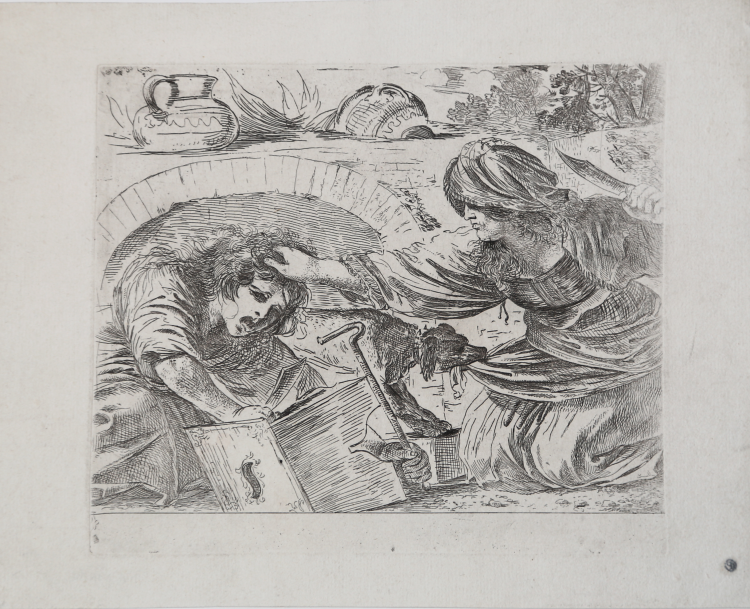




| Reference: | S37768 |
| Author | Giovanni Benedetto CASTIGLIONE detto "Il Grechetto" |
| Year: | 1660 ca. |
| Measures: | 208 x 183 mm |



| Reference: | S37768 |
| Author | Giovanni Benedetto CASTIGLIONE detto "Il Grechetto" |
| Year: | 1660 ca. |
| Measures: | 208 x 183 mm |
Etching, 1660 circa, without inscription. Only state
Excellent example, printed on contemporary laid paper, wide margins, in excellent condition.
P. Bellini (TIB 4602.080): The attribution of this work has long remained controversial. Huber, Gori Gan- dellini, Heinecken, and De Angelis believed it to be by Castiglione, but more recent catalogues by Bartsch, Nagler, and Percy have all excluded it from Castiglione's oeuvre. The work's inclusion in the list of etchings by Castiglione in “Indice delle stampe...della stamperia di Domenico De Rossi in Roma” (Rome, 1705, p. 44) is a pos- sible reason for its attribution to the artist. This also explains the presence of the plate in the Calcografia Nazionale in Rome (inv. 372), where a large number of plates formerly belonging to De Rossi are con- served.
Ubaldo Meroni, however, observes that this work could not be the one cited in the De Rosi Index because it appears "in mezzo foglio reale" (see Lettere e altri documenti... 1978, vol. VIII, p. 3. A drawing that resembles this etching in style, and that was probably its pendant, was sold in Milan in 1977 (see Disegni dal XV al XVIII secolo, galleria "Il gabinetto delle stampe," sale catalogue, November 28, 1977, no. 28). The inscription Benedicte Castiglioni fecit appears at the lower left of the sheet. A print with a similar subject (a brawl in a tavern) was etched in the late 18th century by Gaetano Gandolfi.
|
Bellini, in TIB 4302.080; Heinecken 29; Huber, Winckler, 497; Indice De Rossi 1705, p. 44
|
Giovanni Benedetto CASTIGLIONE detto "Il Grechetto" (Genova 1616 - Mantova 1670)
|
His origin and his edication in Genua led Castiglione to make acquaitance with the Flemish painting, especially through Jaan Roos e Van Dyck from whom he took the warm, vibrating chromatism.
He lived in Rome from 1632 to 1635 and from 1647 to 1651; among the two periods in Rome, he lived in Naples and he also started studying the intellectualistic classicism of Poussin.
His favourite subjects, both in painting and engraving, were taken from the classical moralism of Stoicism, very typical in Poussin, which enabled him to create his own peculiar repertoire, much more refined in comparison with contemporary artists.
He spent his last working years in Mantua, at the Duke’s Palace; the production of this period enhances his chromatism and the visionary elements of his previous production.
Castiglione has been a silful engraver; he loved this particular art for he thought it was the main mean to widespread his iconography. He was the first, in Italy, to appreciate and imitate Rembrandt.
|
|
Bellini, in TIB 4302.080; Heinecken 29; Huber, Winckler, 497; Indice De Rossi 1705, p. 44
|
Giovanni Benedetto CASTIGLIONE detto "Il Grechetto" (Genova 1616 - Mantova 1670)
|
His origin and his edication in Genua led Castiglione to make acquaitance with the Flemish painting, especially through Jaan Roos e Van Dyck from whom he took the warm, vibrating chromatism.
He lived in Rome from 1632 to 1635 and from 1647 to 1651; among the two periods in Rome, he lived in Naples and he also started studying the intellectualistic classicism of Poussin.
His favourite subjects, both in painting and engraving, were taken from the classical moralism of Stoicism, very typical in Poussin, which enabled him to create his own peculiar repertoire, much more refined in comparison with contemporary artists.
He spent his last working years in Mantua, at the Duke’s Palace; the production of this period enhances his chromatism and the visionary elements of his previous production.
Castiglione has been a silful engraver; he loved this particular art for he thought it was the main mean to widespread his iconography. He was the first, in Italy, to appreciate and imitate Rembrandt.
|